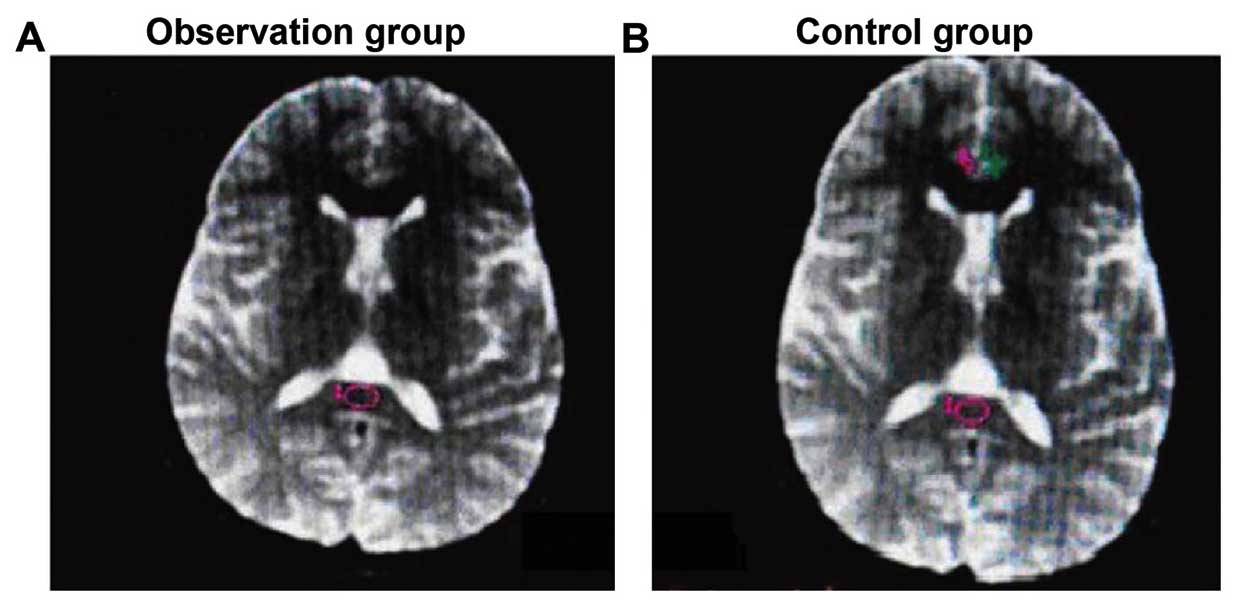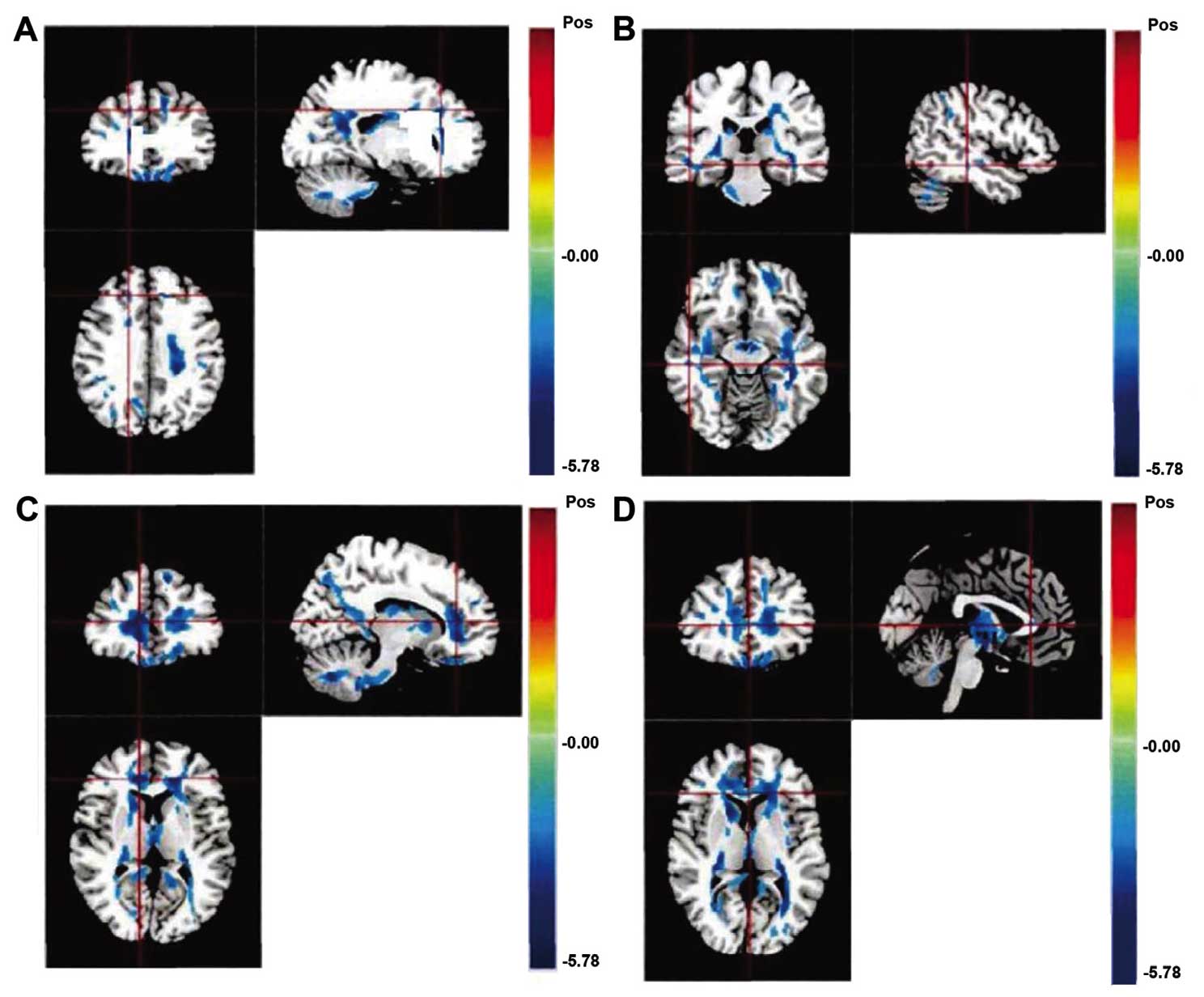|
1
|
No authors listed: Where next with
psychiatric illness? Nature. 336:95–96. 1988. View Article : Google Scholar : PubMed/NCBI
|
|
2
|
Insel TR: Rethinking schizophrenia.
Nature. 468:187–193. 2010. View Article : Google Scholar : PubMed/NCBI
|
|
3
|
Hegarty JD, Baldessarini RJ, Tohen M,
Waternaux C and Oepen G: One hundred years of schizophrenia: A
meta-analysis of the outcome literature. Am J Psychiatry.
151:1409–1416. 1994. View Article : Google Scholar : PubMed/NCBI
|
|
4
|
White T, Magnotta VA, Bockholt HJ,
Williams S, Wallace S, Ehrlich S, Mueller BA, Ho BC, Jung RE, Clark
VP, et al: Global white matter abnormalities in schizophrenia: A
multisite diffusion tensor imaging study. Schizophr Bull.
37:222–232. 2011. View Article : Google Scholar : PubMed/NCBI
|
|
5
|
Miyata J, Sasamoto A, Koelkebeck K, Hirao
K, Ueda K, Kawada R, Fujimoto S, Tanaka Y, Kubota M, Fukuyama H, et
al: Abnormal asymmetry of white matter integrity in schizophrenia
revealed by voxelwise diffusion tensor imaging. Hum Brain Mapp.
33:1741–1749. 2012. View Article : Google Scholar : PubMed/NCBI
|
|
6
|
Skelly LR, Calhoun V, Meda SA, Kim J,
Mathalon DH and Pearlson GD: Diffusion tensor imaging in
schizophrenia: Relationship to symptoms. Schizophr Res. 98:157–162.
2008. View Article : Google Scholar : PubMed/NCBI
|
|
7
|
Ayesa-Arriola R, Rodríguez-Sánchez JM,
Suero ES, Reeves LE, Tabarés-Seisdedos R and Crespo-Facorro B:
Diagnosis and neurocognitive profiles in first-episode
non-affective psychosis patients. Eur Arch Psychiatry Clin
Neurosci. 1:123–125. 2016.
|
|
8
|
Zhang XY, Fan FM, Chen DC, Tan YL, Tan SP,
Hu K, Salas R, Kosten TR, Zunta-Soares G and Soares JC: Extensive
white matter abnormalities and clinical symptoms in drug-naive
patients with first-episode schizophrenia: a voxel-based diffusion
tensor imaging study. J Clin Psychiatry. 77:205–211. 2016.
View Article : Google Scholar : PubMed/NCBI
|
|
9
|
Mamata H, Mamata Y, Westin CF, Shenton ME,
Kikinis R, Jolesz FA and Maier SE: High-resolution line scan
diffusion tensor MR imaging of white matter fiber tract anatomy.
AJNR Am J Neuroradiol. 23:67–75. 2002.PubMed/NCBI
|
|
10
|
Pettersson-Yeo W, Allen P, Benetti S,
McGuire P and Mechelli A: Dysconnectivity in schizophrenia: Where
are we now? Neurosci Biobehav Rev. 35:1110–1124. 2011. View Article : Google Scholar : PubMed/NCBI
|
|
11
|
Salmela MB, Cauley KA, Nickerson JP, Koski
CJ and Filippi CG: Magnetic resonance diffusion tensor imaging
(MRDTI) and tractography in children with septo-optic dysplasia.
Pediatr Radiol. 40:708–713. 2010. View Article : Google Scholar : PubMed/NCBI
|
|
12
|
Ellison-Wright I and Bullmore E:
Meta-analysis of diffusion tensor imaging studies in schizophrenia.
Schizophr Res. 108:3–10. 2009. View Article : Google Scholar : PubMed/NCBI
|
|
13
|
Wolkin A, Choi SJ, Szilagyi S, Sanfilipo
M, Rotrosen JP and Lim KO: Inferior frontal white matter anisotropy
and negative symptoms of schizophrenia: A diffusion tensor imaging
study. Am J Psychiatry. 160:572–574. 2003. View Article : Google Scholar : PubMed/NCBI
|
|
14
|
Rabe-Jablonska J: [Affective disorders in
the fourth edition of the classification of mental disorders
prepared by the American Psychiatric Association - diagnostic and
statistical manual of mental disorders]. Psychiatr Pol. 27:269–279.
1993.PubMed/NCBI
|
|
15
|
Strauss GP, Vertinski M, Vogel SJ,
Ringdahl EN and Allen DN: Negative symptoms in bipolar disorder and
schizophrenia: A psychometric evaluation of the brief negative
symptom scale across diagnostic categories. Schizophr Res.
170:285–289. 2016. View Article : Google Scholar : PubMed/NCBI
|
|
16
|
Siegrist K, Millier A, Amri I, Aballéa S
and Toumi M: Association between social contact frequency and
negative symptoms, psychosocial functioning and quality of life in
patients with schizophrenia. Psychiatry Res. 230:860–866. 2015.
View Article : Google Scholar : PubMed/NCBI
|
|
17
|
Wu CH, Hwang TJ, Chen YJ, Hsu YC, Lo YC,
Liu CM, Hwu HG, Liu CC, Hsieh MH, Chien YL, et al: Primary and
secondary alterations of white matter connectivity in
schizophrenia: A study on first-episode and chronic patients using
whole-brain tractography-based analysis. Schizophr Res. 169:54–61.
2015. View Article : Google Scholar : PubMed/NCBI
|
|
18
|
Meoded A, Faria AV, Hartman AL, Jallo GI,
Mori S, Johnston MV, Huisman TA and Poretti A: Cerebral
Reorganization after Hemispherectomy: A DTI Study. AJNR Am J
Neuroradiol. 14:12–14. 2016.
|
|
19
|
Lei W, Li N, Deng W, Li M, Huang C, Ma X,
Wang Q, Guo W, Li Y, Jiang L, et al: White matter alterations in
first episode treatment-naïve patients with deficit schizophrenia:
A combined VBM and DTI study. Sci Rep. 5:129942015. View Article : Google Scholar : PubMed/NCBI
|
|
20
|
Chung MK, Adluru N, Lee JE, Lazar M,
Lainhart JE and Alexander AL: Cosine series representation of 3D
curves and its application to white matter fiber bundles in
diffusion tensor imaging. Stat Interface. 3:69–80. 2010. View Article : Google Scholar : PubMed/NCBI
|
|
21
|
Chung MK, Adluru N, Lee JE, Lazar M,
Lainhart JE and Alexander AL: Efficient parametric encoding scheme
for white matter fiber bundles. Conf Proc IEEE Eng Med Biol Soc.
2009:6644–6647. 2009.PubMed/NCBI
|
|
22
|
Del Re EC, Konishi J, Bouix S, Blokland
GA, Mesholam-Gately RI, Goldstein J, Kubicki M, Wojcik J, Pasternak
O, Seidman LJ, et al: Enlarged lateral ventricles inversely
correlate with reduced corpus callosum central volume in first
episode schizophrenia: Association with functional measures. Brain
Imaging Behav. 17:156–158. 2015.
|
|
23
|
Whitehouse PJ: Imagery and verbal encoding
in left and right hemisphere damaged patients. Brain Lang.
14:315–332. 1981. View Article : Google Scholar : PubMed/NCBI
|
|
24
|
Rigucci S, Santi G, Corigliano V, Imola A,
Rossi-Espagnet C, Mancinelli I, De Pisa E, Manfredi G, Bozzao A,
Carducci F, et al: White matter microstructure in ultra-high risk
and first episode schizophrenia: A prospective study. Psychiatry
Res. 247:42–48. 2016. View Article : Google Scholar : PubMed/NCBI
|











